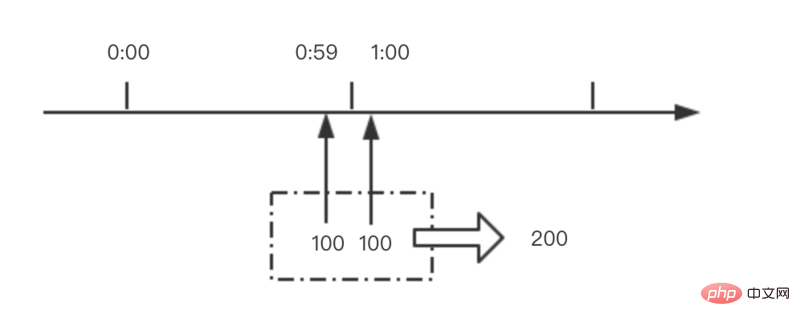간단한 폴링 알고리즘
이 알고리즘은 비교적 간단합니다. 예를 들어 서버가 3개 있다고 가정해 보겠습니다.
| 첫 번째 서버 | 192.168.1.1 |
| 두 번째 서버 | 192.168.1.2 |
| 세 번째 서버 | 192.168.1.3 |
첫 번째 요청이 오면 기본적으로 첫 번째 서버에 접속하고, 두 번째 요청은 두 번째 서버에 접속하고, 세 번째 요청은 세 번째 서버에 접속하게 됩니다. 네 번째 요청은 첫 번째 역을 방문하라는 요청입니다. 다음은 제가 작성한 코드로 구현한 간단한 알고리즘입니다.
public class simplepolling {
/**
* key是ip
*/
public static list <string> ipservice = new linkedlist <>();
static {
ipservice.add("192.168.1.1");
ipservice.add("192.168.1.2");
ipservice.add("192.168.1.3");
}
public static int pos = 0;
public static string getip(){
if(pos >= ipservice.size()){
//防止索引越界
pos = 0;
}
string ip = ipservice.get(pos);
pos ++;
return ip;
}
public static void main(string[] args) {
for (int i = 0; i < 4; i++) {
system.out.println(getip());
}
}
}4번의 시뮬레이션 실행 결과는

이때, 더 좋은 성능을 가진 서버(192.168.1.1 등)가 있다면 이걸 원합니다. 서버에서 더 많은 요청을 처리해야 합니다. 이번에는 가중치 확률이 관련되어 있으므로 이 알고리즘을 구현할 수 없습니다. 나중에 설명하는 폴링 업그레이드 버전 알고리즘을 참조하세요.
Weighted Polling Algorithm
이때 앞에 있는 3개의 서버의 가중치를 설정해야 합니다. 예를 들어 첫 번째 서버는 5, 두 번째 서버는 1, 세 번째 서버는 다음과 같습니다. 서버는 1
| 으로 설정됩니다. 첫 번째 서버 서버 | 192.168.1.1 | 5 |
| 두 번째 서버 | 192.168.1.2 | 1 |
| 세 번째 서버 | 192.168.1.3 | 1 |
현재 상위 5개 각 요청은 첫 번째 서버에 액세스하고, 여섯 번째 요청은 두 번째 서버에 액세스하고, 일곱 번째 요청은 세 번째 서버에 액세스합니다.
다음은 제가 제시한 코드 예시입니다.
public class weightpolling {
/**
* key是ip,value是权重
*/
public static map<string, integer> ipservice = new linkedhashmap<>();
static {
ipservice.put("192.168.1.1", 5);
ipservice.put("192.168.1.2", 1);
ipservice.put("192.168.1.3", 1);
}
public static int requestid = 0;
public static int getandincrement() {
return requestid++;
}
public static string getip(){
//获取总的权重
int totalweight =0;
for (integer value : ipservice.values()) {
totalweight+= value;
}
//获取当前轮询的值
int andincrement = getandincrement();
int pos = andincrement% totalweight;
for (string ip : ipservice.keyset()) {
if(pos < ipservice.get(ip)){
return ip;
}
pos -= ipservice.get(ip);
}
return null;
}
public static void main(string[] args) {
for (int i = 0; i < 7; i++) {
system.out.println(getip());
}
}
} 이때 실행 결과는

처음으로 보이는 서버는 5번 실행되었고, 다음 2개의 서버는 1번 실행되었으며, 곧. 아마도 이 알고리즘이 나쁘지 않다고 생각할 수도 있습니다. 실제로 이 알고리즘의 한 가지 단점은 첫 번째 서버의 가중치가 너무 크면 첫 번째 서버에 많은 요청을 실행해야 할 수도 있다는 것입니다. 이 경우 분포가 고르지 않아 특정 서버에 부담을 줄 수 있습니다. 과도한 크기는 붕괴로 이어집니다. 그래서 나중에 이 문제를 해결하기 위해 세 번째 알고리즘을 소개하겠습니다
Smooth Weighted Polling Algorithms
이 알고리즘은 더 복잡할 수도 있습니다. 나중에 관련 정보를 읽었을 때 이해가 되지 않았습니다. 여기에서 예시로 든 서버 구성과 무게는 여전히 위와 같습니다
| request | 현재 체중 = 본인 체중 + 선택 후 현재 체중 | 총 중량 | 현재 최대 중량 | 반환 IP | 선택 후 현재 중량 = 현재 최대 중량 - 총 중량 |
|---|---|---|---|---|---|
| {5,1,1} | 7 | 5 | 192. 168 .1.1 | {-2, 1,3 ,3} | 7 |
| 192.168.1.2 | {1,-4,3} | 4 | {6,-3,4} | 7 | |
| 192.16 8.1.1 | {-1,-3,4} | 5 | {4,-2,5} | 7 | |
| 192.168 .1.3 | {4,-2,-2} | 6 | {9,-1,-1} | 7 | |
| 192.168.1.1 | {2,-1,-1} | 7 | {7,0,0} | 7 | |
| 192.168.1.1 | {0,0,0} | 위 사진에서 볼 수 있듯이, 무게는 첫 번째 서버는 5로 설정되어 있으며 다섯 번째 요청은 아니지만 모두 첫 번째 서버에서 실행되지만 스케줄링 순서는 매우 균일하며 현재 가중치는 {0, 0, 0} 7번째 스케줄링에서 인스턴스의 상태가 초기 상태와 일치하므로 향후에도 스케줄링 작업이 반복될 수 있습니다. | 이전 그림의 의미를 명확하게 이해하지 못하실 수도 있습니다. 여기서 간단히 설명하겠습니다. | ||
| 2 2장에서. 요청이 들어오면 현재 가중치 선택 값을 기본적으로 {0,0,0}으로 초기화하므로 현재 가중치 값은 {5+0,1+0,1+0}입니다. 5,1,1은 앞서 설정한 각 서버별로 설정된 가중치입니다. | 3. 여기서 첫 번째 요청의 최대 가중치는 5라고 결론을 내릴 수 있습니다. 그런 다음 첫 번째 서버 ip로 돌아갑니다 | 4. 그러면 선택 후 현재 가중치를 설정합니다. 현재 최대 가중치에서 전체 가중치(5-7)를 뺀 값입니다. 이때 선택되지 않은 가중치는 변경되지 않습니다. 현재 가중치의 선택된 가중치를 구합니다. | 5. 두 번째 요청이 오면 위의 2, 3, 4단계를 계속합니다. 여기서는 이해가 되지 않습니다. 아래에 자체 Java 코드를 제공하겠습니다. 구현된 알고리즘: | 여기 코드의 실행 결과는 다음과 같습니다. |
위 내용은 Nginx가 폴링 알고리즘을 구현하는 방법의 상세 내용입니다. 자세한 내용은 PHP 중국어 웹사이트의 기타 관련 기사를 참조하세요!
 内存飙升!记一次nginx拦截爬虫Mar 30, 2023 pm 04:35 PM
内存飙升!记一次nginx拦截爬虫Mar 30, 2023 pm 04:35 PM本篇文章给大家带来了关于nginx的相关知识,其中主要介绍了nginx拦截爬虫相关的,感兴趣的朋友下面一起来看一下吧,希望对大家有帮助。
 nginx限流模块源码分析May 11, 2023 pm 06:16 PM
nginx限流模块源码分析May 11, 2023 pm 06:16 PM高并发系统有三把利器:缓存、降级和限流;限流的目的是通过对并发访问/请求进行限速来保护系统,一旦达到限制速率则可以拒绝服务(定向到错误页)、排队等待(秒杀)、降级(返回兜底数据或默认数据);高并发系统常见的限流有:限制总并发数(数据库连接池)、限制瞬时并发数(如nginx的limit_conn模块,用来限制瞬时并发连接数)、限制时间窗口内的平均速率(nginx的limit_req模块,用来限制每秒的平均速率);另外还可以根据网络连接数、网络流量、cpu或内存负载等来限流。1.限流算法最简单粗暴的
 nginx php403错误怎么解决Nov 23, 2022 am 09:59 AM
nginx php403错误怎么解决Nov 23, 2022 am 09:59 AMnginx php403错误的解决办法:1、修改文件权限或开启selinux;2、修改php-fpm.conf,加入需要的文件扩展名;3、修改php.ini内容为“cgi.fix_pathinfo = 0”;4、重启php-fpm即可。
 nginx+rsync+inotify怎么配置实现负载均衡May 11, 2023 pm 03:37 PM
nginx+rsync+inotify怎么配置实现负载均衡May 11, 2023 pm 03:37 PM实验环境前端nginx:ip192.168.6.242,对后端的wordpress网站做反向代理实现复杂均衡后端nginx:ip192.168.6.36,192.168.6.205都部署wordpress,并使用相同的数据库1、在后端的两个wordpress上配置rsync+inotify,两服务器都开启rsync服务,并且通过inotify分别向对方同步数据下面配置192.168.6.205这台服务器vim/etc/rsyncd.confuid=nginxgid=nginxport=873ho
 如何解决跨域?常见解决方案浅析Apr 25, 2023 pm 07:57 PM
如何解决跨域?常见解决方案浅析Apr 25, 2023 pm 07:57 PM跨域是开发中经常会遇到的一个场景,也是面试中经常会讨论的一个问题。掌握常见的跨域解决方案及其背后的原理,不仅可以提高我们的开发效率,还能在面试中表现的更加
 Linux系统下如何为Nginx安装多版本PHPMay 11, 2023 pm 07:34 PM
Linux系统下如何为Nginx安装多版本PHPMay 11, 2023 pm 07:34 PMlinux版本:64位centos6.4nginx版本:nginx1.8.0php版本:php5.5.28&php5.4.44注意假如php5.5是主版本已经安装在/usr/local/php目录下,那么再安装其他版本的php再指定不同安装目录即可。安装php#wgethttp://cn2.php.net/get/php-5.4.44.tar.gz/from/this/mirror#tarzxvfphp-5.4.44.tar.gz#cdphp-5.4.44#./configure--pr
 nginx部署react刷新404怎么办Jan 03, 2023 pm 01:41 PM
nginx部署react刷新404怎么办Jan 03, 2023 pm 01:41 PMnginx部署react刷新404的解决办法:1、修改Nginx配置为“server {listen 80;server_name https://www.xxx.com;location / {root xxx;index index.html index.htm;...}”;2、刷新路由,按当前路径去nginx加载页面即可。
 nginx怎么禁止访问phpNov 22, 2022 am 09:52 AM
nginx怎么禁止访问phpNov 22, 2022 am 09:52 AMnginx禁止访问php的方法:1、配置nginx,禁止解析指定目录下的指定程序;2、将“location ~^/images/.*\.(php|php5|sh|pl|py)${deny all...}”语句放置在server标签内即可。


핫 AI 도구

Undresser.AI Undress
사실적인 누드 사진을 만들기 위한 AI 기반 앱

AI Clothes Remover
사진에서 옷을 제거하는 온라인 AI 도구입니다.

Undress AI Tool
무료로 이미지를 벗다

Clothoff.io
AI 옷 제거제

AI Hentai Generator
AI Hentai를 무료로 생성하십시오.

인기 기사

뜨거운 도구

SublimeText3 영어 버전
권장 사항: Win 버전, 코드 프롬프트 지원!

SublimeText3 중국어 버전
중국어 버전, 사용하기 매우 쉽습니다.

WebStorm Mac 버전
유용한 JavaScript 개발 도구

SublimeText3 Mac 버전
신 수준의 코드 편집 소프트웨어(SublimeText3)

SublimeText3 Linux 새 버전
SublimeText3 Linux 최신 버전

뜨거운 주제
 1374
1374 52
52 39
39 19
19


